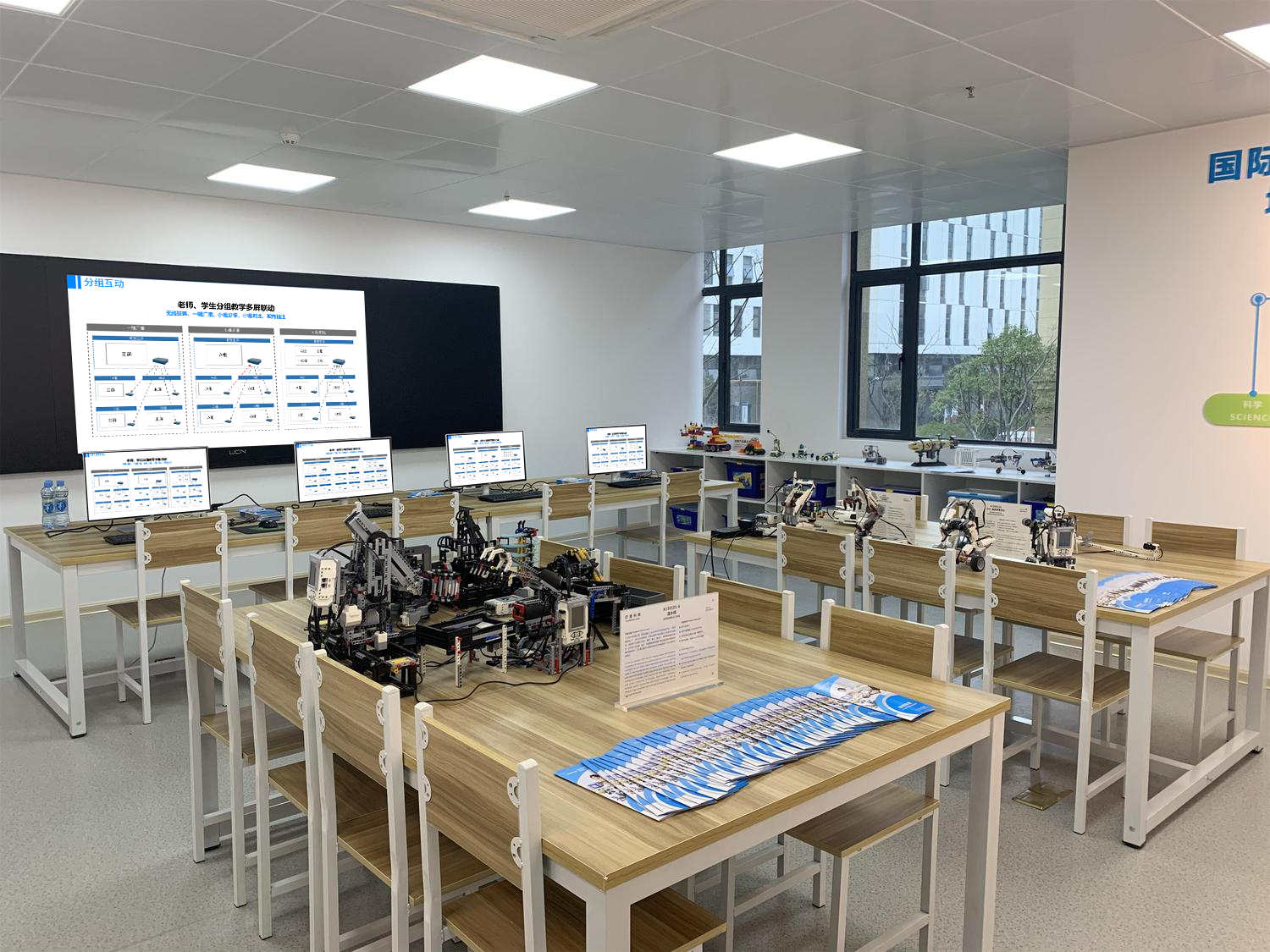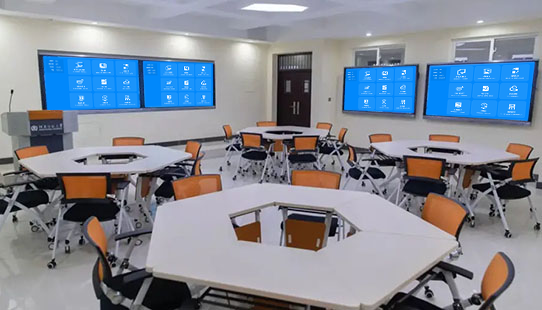Smart Classrooms: An Intelligent Space Solution for Empowering Educational Innovation
The smart classroom solution is centered on “technology integrating with education.” By building an intelligent ecosystem of interconnected devices, creating interactive teaching scenarios, and establishing a data-driven management system, it breaks down the boundaries of traditional teaching. This transforms the classroom from one-way instruction to multi-dimensional interaction and from experience-based teaching to precision-based teaching.
I. Intelligent Hardware Architecture: All-Scenario Device Collaboration
The solution uses a “1+N” distributed device architecture. With a 4K touch main screen as the core, it links to N types of devices, such as an AI camera, a wireless screen mirroring terminal, student interactive tablets, and environmental sensors, forming an intelligent network that covers the entire teaching, learning, and management process.
- Multi-Protocol Wireless Interconnection: It supports 8 mainstream mirroring protocols like AirPlay, Miracast, and WiDi. One-click mirroring from iOS, Android, and Windows devices has a response time of ≤3 seconds. Older devices can connect seamlessly via a QR code mirroring function, with a device adaptation rate of 99.6%.
- AI Sensing System: A 120° wide-angle AI camera supports teacher and student facial recognition, behavioral analysis, and automatic framing, generating real-time data on classroom focus. A 6-array microphone provides a pickup range of 5 meters and sound source localization, automatically filtering out environmental noise from air conditioners and projectors, with a voice recognition accuracy of 98%.
- Environmental Adaptive Adjustment: Temperature, humidity, and light sensors link with the air conditioning and smart lighting to automatically adjust the classroom environment to a comfortable range of 24°C ± 1°C and 50% ± 5% humidity. The illumination in the projector screen area is automatically dimmed by 30% to enhance the viewing experience.
II. Core Teaching Functions: From Interaction to Personalization
(I) Immersive Interactive System
- Multi-Screen Collaborative Annotation: Teacher annotations on the main screen are synchronized in real time to all student terminals. It supports up to 8 students annotating the mirrored content simultaneously in different colors, and historical annotations can be reviewed and compared. In a math class, students can use a stylus to draw auxiliary lines on a geometric figure, and the teacher’s terminal receives and comments on them in real time.
- Group Discussion Space: Each group is equipped with a 21.5-inch touch screen that supports in-group file transfers and screen sharing. Discussion results can be “pushed” to the main screen for a split-screen display with one click. In a Chinese language class, when analyzing a poem’s imagery, the annotations from each group form a comparison chart on the main screen, deepening the dimensions of understanding.
- Virtual-Real Integration Teaching: It integrates an AR mirroring function. A teacher can scan a textbook with a tablet to trigger a 3D model. For example, in a biology class, they can scan a human body illustration to display a three-dimensional organ structure, which supports 360° rotation and dissection demonstrations, increasing the tangibility of abstract knowledge by 60%.
(II) Precision Teaching Engine
- Real-Time Academic Feedback: A teacher can launch question types like multiple-choice, fill-in-the-blank, or short-answer questions. Students answer on their interactive tablets, and a data dashboard is generated in 3 seconds, showing the distribution of accuracy, a heatmap of incorrect options, and a collection of typical answers. When the error rate for an English listening question exceeds 70%, the system automatically pushes similar listening materials to student terminals.
- Personalized Resource Push: Based on student answer data, it builds a knowledge graph and intelligently matches weak areas. For a student weak in the “mechanics” module of physics, they will receive targeted micro-lectures, practice questions, and experimental videos. The system generates a “Learning Diagnostic Report” every week to help the teacher adjust their teaching strategy.
- Process-Based Evaluation System: It automatically records process data like classroom speeches, interactive annotations, and group contributions. This data is combined with homework and test scores to form a comprehensive evaluation, replacing the traditional “one-exam-determines-all” model and expanding the evaluation dimensions from 3 to 8.

III. Scenario-Based Teaching Practices
(I) Theoretical Classes: Making Abstract Knowledge Tangible
- Dynamic Demonstration: In a chemistry class, a teacher can mirror a video of an acid-base neutralization experiment and use a stylus to annotate the trajectory of ion reactions. Student terminals can slow down key frames and add annotations. In a history class, a timeline mirroring function can compare the territorial changes of different dynasties, and clicking a node displays corresponding historical materials.
- Debate-Style Learning: The class is divided into pro and con sides, and the main screen displays a split-screen view of their arguments. The AI assistant captures keyword frequencies from the debate in real time, generating a logical correlation graph that helps students sort out their line of reasoning, improving the efficiency of critical thinking cultivation by 40%.
(II) Experimental Classes: Making Procedures Traceable and Evaluatable
- Microscopic Experiment Mirroring: A microscope camera can be used to mirror the process of cell division to the main screen, which supports 4K magnification and frame rate adjustment, so the whole class can observe chromosome changes. Students can use their phones to film the experimental procedure, and after uploading it to the system, it automatically generates a score for their operational standardization.
- Virtual Simulation Operation: Dangerous or high-cost experiments (such as high-voltage electricity experiments) can be completed via VR mirroring. Students wear lightweight VR glasses to perform the operations, and the main screen displays the operation footage and a step-by-step score. Incorrect operations trigger a safety warning, reducing the accident rate to 0.
(III) Cross-School Collaborative Classes: Making Quality Resources Flow
- Synchronized Classrooms: The main screen content of an urban teacher is synchronized in real time to a rural classroom. Students from both locations can use interactive tablets to answer questions and ask questions, and the rural students’ answer data is fed back to the main lecturer in real time, enabling them to “be in the same class.”
- Collaborative Research Projects: Students from different schools can team up to complete a project on “local climate change.” They can share meteorological data and on-site investigation videos via cross-school mirroring and work together to draw analysis charts on the main screen, cultivating collaboration and research skills.
IV. Smart Management System
(I) Full-Link Operations and Maintenance Platform
- Device Status Monitoring: An administrator can view the operational data of all classroom devices via a backend: projector lamp life, interactive screen touch accuracy, network bandwidth usage, etc. The system automatically sends alarms for abnormal status. The remote troubleshooting rate is 85%, and on-site maintenance costs are reduced by 60%.
- Teaching Resource Management: It builds a school-based resource library categorized by “subject – grade level – knowledge point.” It supports the uploading, review, and version management of courseware, videos, and practice questions. Teachers can call up a resource with a single click and add personal annotations, cutting lesson preparation time by 50%.
(II) Security and Permission Control
- Content Moderation Mechanism: Student-mirrored content needs to be previewed and confirmed by the teacher’s terminal. Sensitive words are automatically blocked. Class recordings are stored locally with encryption, and only authorized teachers can view them, which complies with educational data security standards.
- Tiered Permission Management: The teacher has permissions for resource pushing and screen control. Students can only access course-related content. The visitor mode restricts mirroring and data viewing functions to ensure classroom order.
V. Tangible Results: From Technology Application to Educational Transformation
After a key provincial middle school deployed this solution, the frequency of classroom interactions increased from 12 times per class to 38 times, and students’ active questioning rate rose by 75%. The average grades of weak students improved by 23 points, and the average lesson preparation time for teachers was reduced from 4 hours per day to 1.5 hours. Parent satisfaction with the teaching process reached 98%.
The core value of the smart classroom is not in piling up technology but in making technology invisible within the teaching process. When teachers don’t have to worry about operating devices and students don’t have to worry about the barrier to interaction, the essential power of education can be fully unleashed, making the classroom a truly fertile ground for cultivating wisdom.